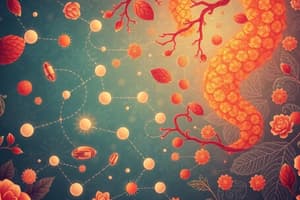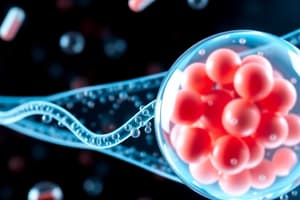Podcast
Questions and Answers
What is the primary factor that affects the absorption of a drug?
What is the primary factor that affects the absorption of a drug?
- Dosage form
- Route of administration (correct)
- Blood flow
- Lipid solubility
What is the primary organ responsible for phase I metabolism?
What is the primary organ responsible for phase I metabolism?
- Intestines
- Liver (correct)
- Kidneys
- Lungs
Which pharmacokinetic parameter is defined as the rate at which a drug is eliminated from the body?
Which pharmacokinetic parameter is defined as the rate at which a drug is eliminated from the body?
- Bioavailability
- Volume of Distribution
- Half-Life
- Clearance (correct)
What is the primary application of the two-compartment model in pharmacokinetics?
What is the primary application of the two-compartment model in pharmacokinetics?
What is the primary method of excretion for water-soluble drugs?
What is the primary method of excretion for water-soluble drugs?
What is the primary factor that affects the distribution of a drug?
What is the primary factor that affects the distribution of a drug?
What is the primary application of pharmacokinetic parameters in clinical practice?
What is the primary application of pharmacokinetic parameters in clinical practice?
What is the primary unit of measurement for the volume of distribution?
What is the primary unit of measurement for the volume of distribution?
Flashcards are hidden until you start studying
Study Notes
Pharmacokinetics
Definition: The study of the movement of drugs within the body, including absorption, distribution, metabolism, and excretion.
Key Concepts:
- Absorption:
- The process by which a drug enters the bloodstream
- Factors affecting absorption: route of administration, dosage form, pH, and blood flow
- Distribution:
- The process by which a drug is dispersed throughout the body
- Factors affecting distribution: blood flow, protein binding, and lipid solubility
- Metabolism:
- The process by which a drug is chemically altered by the body
- Types of metabolism: phase I (oxidation, reduction, hydrolysis) and phase II (conjugation)
- Major organs involved in metabolism: liver, kidneys, and intestines
- Excretion:
- The process by which a drug is eliminated from the body
- Major routes of excretion: kidneys (urine), liver (bile), and lungs (exhaled air)
Pharmacokinetic Parameters:
- Bioavailability (F): The percentage of the administered dose that reaches the systemic circulation
- Volume of Distribution (Vd): The apparent volume of fluid that contains the drug at the same concentration as the plasma
- Clearance (CL): The rate at which a drug is eliminated from the body
- Half-Life (t1/2): The time it takes for the plasma concentration of a drug to decrease by 50%
Pharmacokinetic Models:
- One-Compartment Model: A simple model that assumes the drug is distributed uniformly throughout the body
- Two-Compartment Model: A more complex model that assumes the drug is distributed between two compartments: central and peripheral
Clinical Applications:
- Dose Adjustment: Pharmacokinetic parameters are used to adjust the dose of a drug based on individual patient factors, such as age, weight, and renal function
- Therapeutic Drug Monitoring: Pharmacokinetic parameters are used to monitor the plasma concentration of a drug and adjust the dose accordingly
Pharmacokinetics
- Study of the movement of drugs within the body, including absorption, distribution, metabolism, and excretion
Absorption
- Process by which a drug enters the bloodstream
- Factors affecting absorption:
- Route of administration
- Dosage form
- pH
- Blood flow
Distribution
- Process by which a drug is dispersed throughout the body
- Factors affecting distribution:
- Blood flow
- Protein binding
- Lipid solubility
Metabolism
- Process by which a drug is chemically altered by the body
- Types of metabolism:
- Phase I (oxidation, reduction, hydrolysis)
- Phase II (conjugation)
- Major organs involved in metabolism:
- Liver
- Kidneys
- Intestines
Excretion
- Process by which a drug is eliminated from the body
- Major routes of excretion:
- Kidneys (urine)
- Liver (bile)
- Lungs (exhaled air)
Pharmacokinetic Parameters
- Bioavailability (F): Percentage of the administered dose that reaches the systemic circulation
- Volume of Distribution (Vd): Apparent volume of fluid that contains the drug at the same concentration as the plasma
- Clearance (CL): Rate at which a drug is eliminated from the body
- Half-Life (t1/2): Time it takes for the plasma concentration of a drug to decrease by 50%
Pharmacokinetic Models
- One-Compartment Model: Simple model that assumes the drug is distributed uniformly throughout the body
- Two-Compartment Model: More complex model that assumes the drug is distributed between two compartments: central and peripheral
Clinical Applications
- Dose Adjustment: Pharmacokinetic parameters are used to adjust the dose of a drug based on individual patient factors, such as age, weight, and renal function
- Therapeutic Drug Monitoring: Pharmacokinetic parameters are used to monitor the plasma concentration of a drug and adjust the dose accordingly
Studying That Suits You
Use AI to generate personalized quizzes and flashcards to suit your learning preferences.




